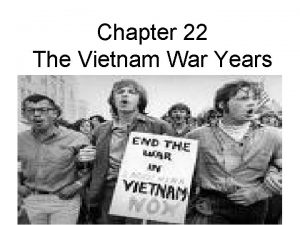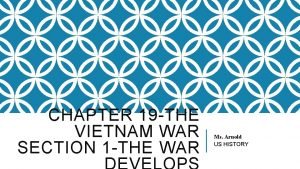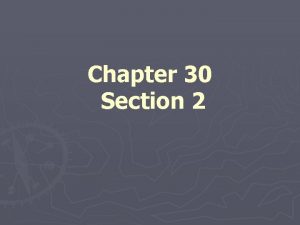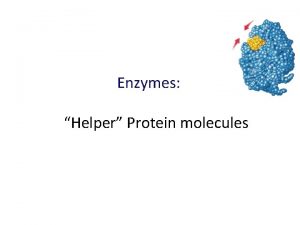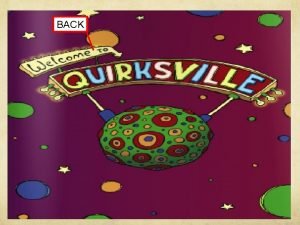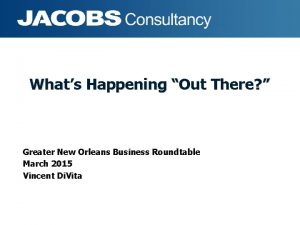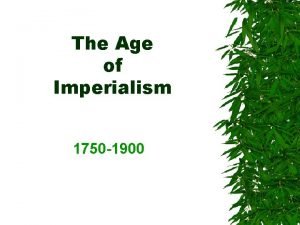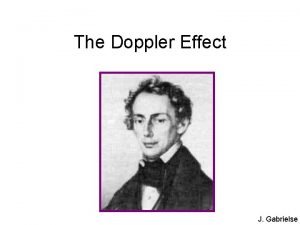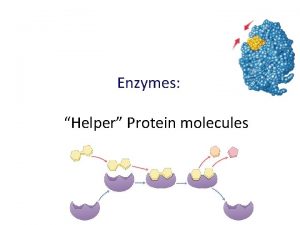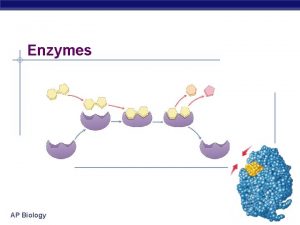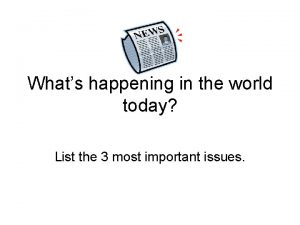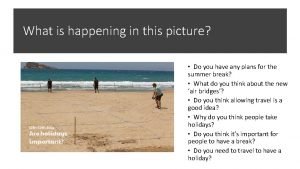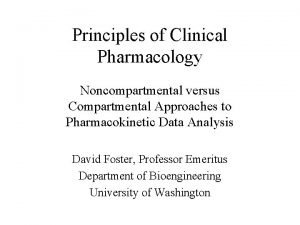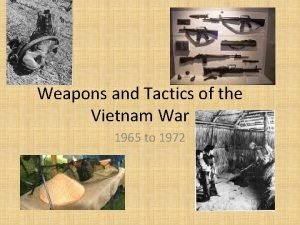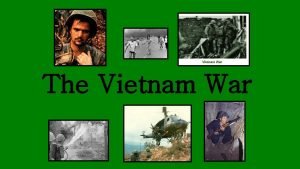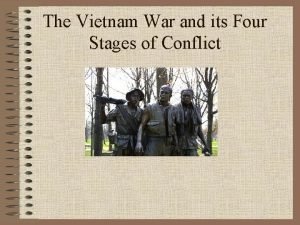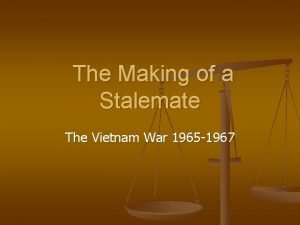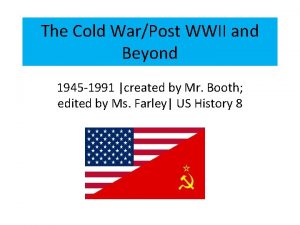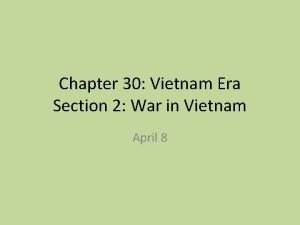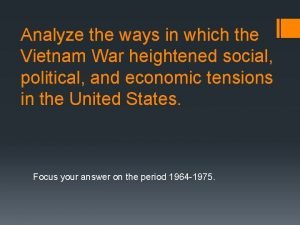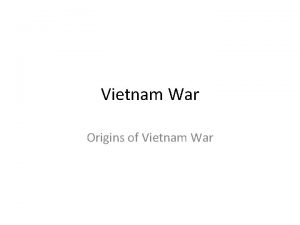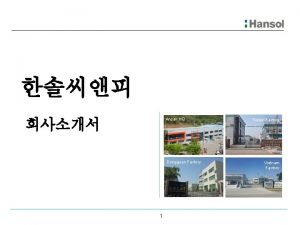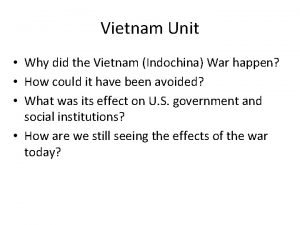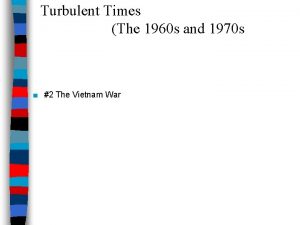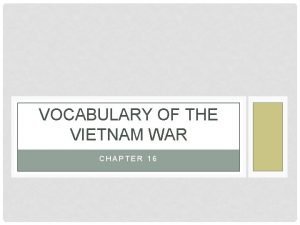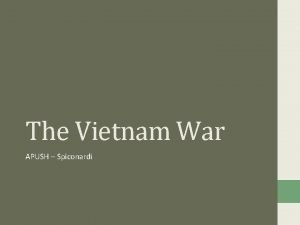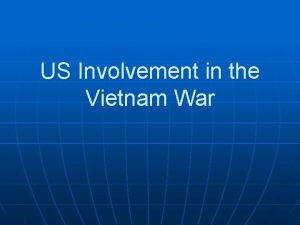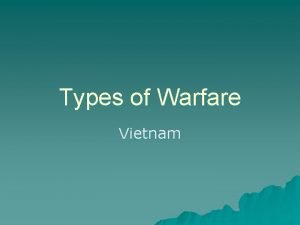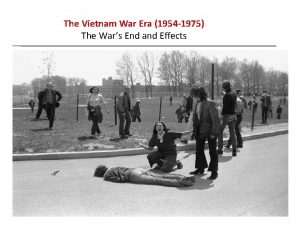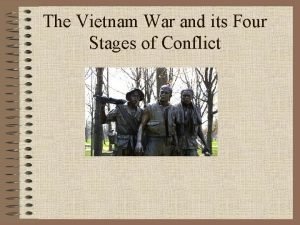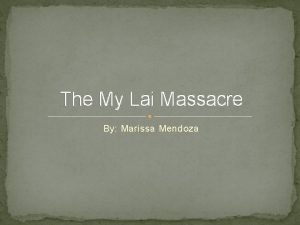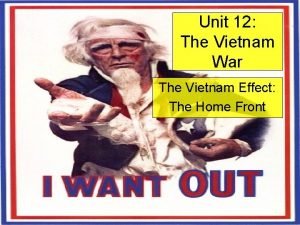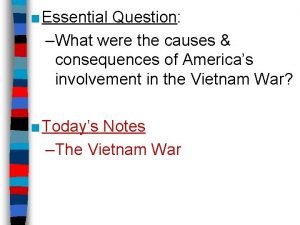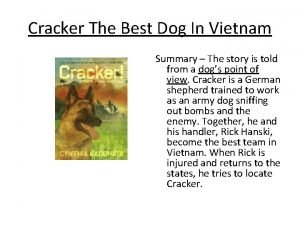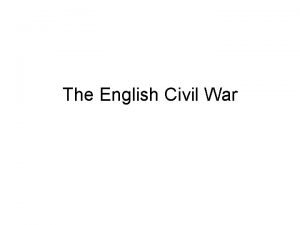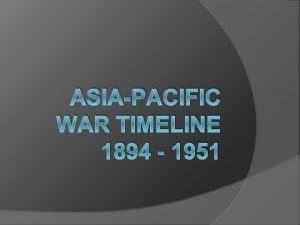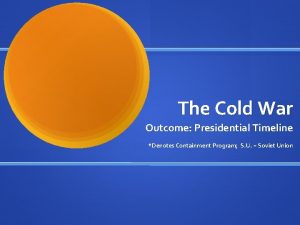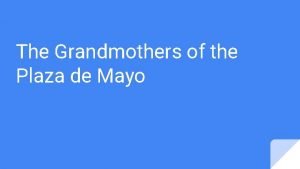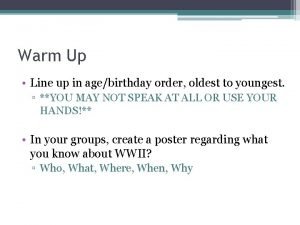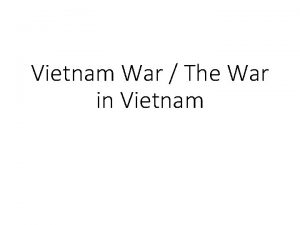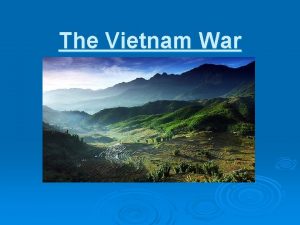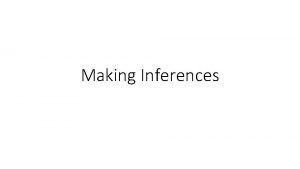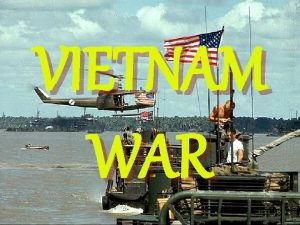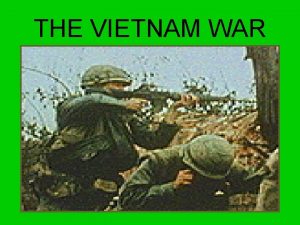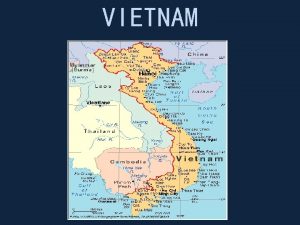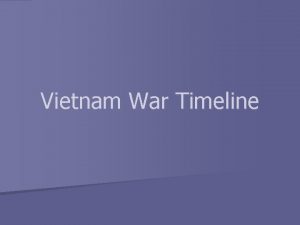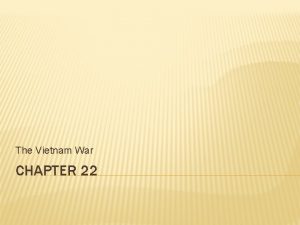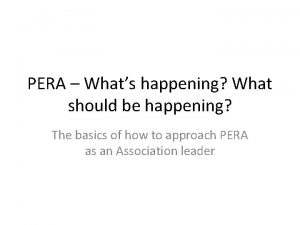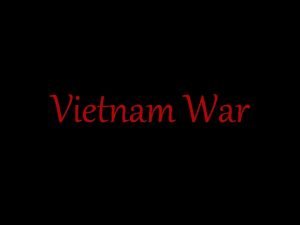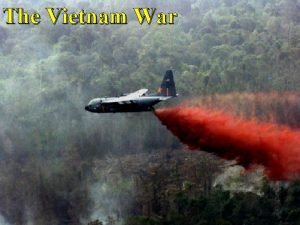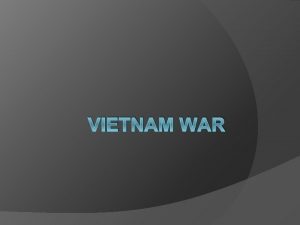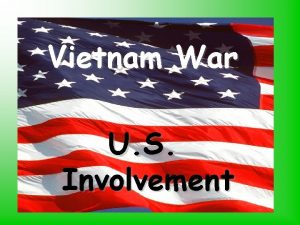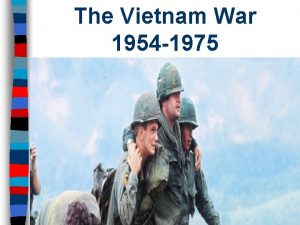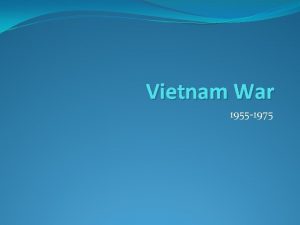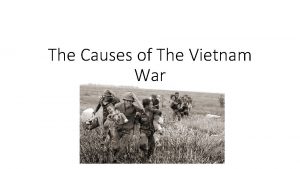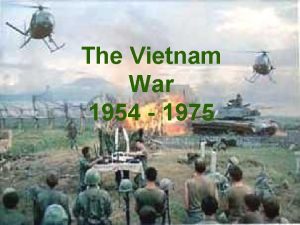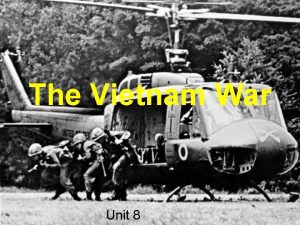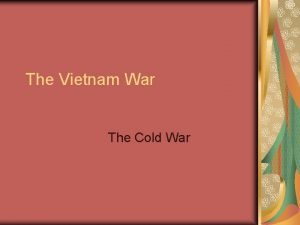The Vietnam War Chapter 22 Timeline Whats Happening



















































































- Slides: 83

The Vietnam War: Chapter 22

Timeline: What’s Happening? Ø Ø Ø United States: 1965 – first major US combat units arrive in Vietnam 1968 – RFK and MLK are assassinated 1970 – Kent State Massacre 1973 – US signs ceasefire with North Vietnam and Vietcong Ø Ø Ø World: 1966 – Mao Zedong begins cultural revolution in China 1975 – Communists capture Saigon and South Vietnamese surrender

SECTION 1 Moving Toward Conflict Ø By the end of this lesson, I will be able to: Summarize Vietnam's history as a French colony and its struggle for independence. 2. Examine how the United States became involved in the Vietnam conflict. 3. Describe the expansion of U. S. military involvement under President Johnson. 1.

Section One: Moving Toward Conflict Ø Main Idea: To stop the spread of communism in Southeast Asia, the Untied States used its military to support South Vietnam. Ø Why it Matters Now: The United States support role in Vietnam began what would become America’s longest and most controversial war in its history. Ø Key Terms: Ho Chi Minh Vietminh Domino Theory Dien Bien Phu Geneva Accords Ø Key Terms: Ngo Dinh Diem Vietcong Ho Chi Minh Trail Tonkin Gulf Resolution Ø Ø Ø Ø Ø

French Rule in Vietnam: Since the late 1800’s, the French ruled Vietnam, Laos, and Cambodia Ø After WWII, France tried to regain control of these territories Ø USA supported France with over 1 billion dollars…and military support (fear of communism) Ø

French Rule in Vietnam Ø Ø The Vietnamese fled to China to escape the harsh French rule A communist party was formed underneath Ho Chi Minh In 1940, the Japanese took over Vietnam Ho Chi Minh formed the Vietminh – goal was to gain independence from all foreign rule


French Rule in Vietnam: Ø Ø Ø In 1950, the US sent $15 million in aid to the French to help them defeat the Vietminh The French eventually surrendered at Dien Bien Phu – French outpost France, Great Britain, Soviet Union, USA, China, Laos, and Cambodia all met with the Vietminh to set up a peace plan – Geneva Accords This peace plan divided Vietnam into: North Vietnam – Communist South Vietnam – Anticommunist


The United States Steps In: Ø Ø After the French defeat, the United States took a more active role in halting the spread of communism Ho Chi Minh became a national hero despite his tough leadership South Vietnam’s president – Ngo Dinh Diem refused to take part in a countrywide election (he would lose) The USA (Eisenhower) promised Diem aid and training to build a strong government in South Vietnam

The US Steps In: Diem didn’t use the funds as he should angered many Ø A strong communist group called the Vietcong had begun attacks on Diem’s government – assassinated thousands of South Vietnamese government officials. Ø Ho Chi Minh supported the group with weapons and money Ø He sent supplies via the Ho Chi Minh Trail Ø


Kennedy and Vietnam: Ø Ø Ø Kennedy initially sent Diem more supplies, money, and military advisors By the end of 1963, 16, 000 US military personnel were in South Vietnam Diem started to move Vietnamese families into safer areas (which they resented) Diem also attacked Buddhists (he was Catholic) He burned temples, and killed hundreds of Buddhist clerics (some protested) Against Kennedy’s wishes Diem was assassinated (USA government coup in S. Vietnam)


President Johnson Expands the Conflict: Ø Ø Kennedy wanted out of Vietnam – he was assassinated though, so Johnson takes over Johnson will escalate America’s role in Vietnam South Vietnam grew even more unstable after Diem was assassinated Still, he and the America public feared communism – Domino Theory – once one country becomes communist, they will ALL become communist

Tonkin Gulf Resolution: In 1965, eight Americans were killed in an attack by the Vietcong Ø In response, Operation Rolling Thunder became the first sustained bombing of North Vietnam Ø Within 4 months more than 50, 000 US soldiers were battling the Vietcong. Ø

The Tonkin Gulf Resolution: Ø Ø Ø In 1964, a North Vietnam torpedo was fired at an American ship ( USS Maddox) The torpedo missed, and the Maddox opened fire on the patrol boat Two days later, the American ships reported enemy fire and opened fire on enemy ships (later it was found that there was no enemy fire) Johnson decided then to start dropping bombs on North Vietnam The Tonkin Gulf Resolution granted Johnson broad military powers in Vietnam

Discussion Questions: Ø 1. How were France and the USA involved with Vietnam even before the war began? Ø 2. Why did South Vietnam become increasingly unstable? Ø 3. Do you agree with President Johnson’s response to the Vietcong attack on the eight Americans?

SECTION 2 U. S. Involvement and Escalation Ø By the end of this lesson, I will be able to: Explain the reasons for the escalation of U. S. involvement in Vietnam. 2. Describe the military tactics and weapons used by U. S. forces and the Vietcong. 3. Explain the impact of the war on American society. 1.

Section Two: U. S. Involvement and Escalation: Ø Main Idea: The United States sent troops to fight in Vietnam, but the war quickly turned into a stalemate. Ø Why it Matters Now: Since Vietnam, Americans are more aware of the positive and negative effects of using US troops in foreign conflicts. Ø Key Terms: Robert Mc. Namara Dean Rusk William Westmoreland Army of the Republic of Vietnam Ø Key Terms: Napalm Agent Orange Search and destroy missions Credibility gap Ø Ø Ø Ø

Johnson Increases US Involvement: At this time, the American public supported Johnson’s determination to contain communism in Vietnam Ø He would later send large numbers of troops to fight alongside the South Vietnamese. Ø

Strong Support For Containment: Ø Ø Ø Johnson was initially opposed to sending ground troops into Vietnam “I am not about to send American boys 9 or 10, 000 miles away from home to do what Asian boys ought to be doing for themselves. ” Soon after (March 1965), he began sending tens of thousands of troops to fight in Vietnam His close advisors (Robert Mc. Namara, Dean Rusk) pushed him towards this In 1965, 61% of Americans supported the war, while 24% opposed it


The Troop Buildup Accelerates: By the end of 1965, the US government had sent more than 180, 000 Americans to Vietnam Ø American commander in S. Vietnam – William Westmoreland (served in WII and Korea), continued to request more troops Ø Westmoreland was not impressed with the S. Vietnamese soldiers (Army Republic of Vietnam) Ø By 1967, 500, 000 US troops were in Vietnam Ø

Fighting in The Jungle: US believed its superior weaponry would lead to victory over the Vietcong Ø Vietcong used hit and run tactics because of their lack of high powered weaponry Ø The also had key knowledge of the jungle terrain Ø

An Elusive Enemy: The Vietcong lived amongst the people, so it was hard to tell who was friend or foe Ø The Vietcong also had elaborate networks of tunnels Ø These tunnels could withstand airstrikes, help them launch surprise attacks and then disappear. Ø

An Elusive Enemy (cont) The tunnels were burrowed deep and often connected villages Ø “The more the Americans tried to drive us away from our land, the more we burrowed into it. ” – Leader of the Vietcong Ø The terrain was laced with booby traps and land mines from both sides Ø



A Frustrating War of Attrition: Westmoreland’s strategy was attrition – destroy their morale and wear them down Ø He also introduced the idea of a “body count” to encourage his men and discourage the enemy Ø The US viewed Vietnam as a military struggle – the Vietcong viewed Vietnam as a battle for there very existence Ø

Discussion: Ø 1. In what ways do you think the Vietcong’s attitude helped them to fight the US soldiers? Ø 2. What are your thoughts on Westmoreland’s war of attrition and the body count? (Morale)

The Battle for “Hearts and Minds” American forces tried to win over the S. Vietnamese so that they wouldn’t join the Vietcong Ø US planes dropped Napalm – gas bombs – to set fire to the jungle Ø They also sprayed agent orange – a leaf killing toxic chemical (cancerous) Ø These weapons left villages and innocent civilians devastated Ø

Devastating Missions: US soldiers conducted search and destroy missions – killing suspected Vietcong members, their livestock, and burning their villages Ø Many villagers fled to refugee camps (over 3 million people) in S. Vietnam Ø

Sinking Morale Troops eventually became frustrated because of: Ø 1. Guerilla warfare Ø 2. Harsh Jungle Conditions Ø 3. Making No Headway against the enemy Ø

Sinking Morale (cont) Many troops turned to alcohol, drugs, prostitution, and infighting among their own men Ø Morale would worsen later when soldiers realized they were fighting even though their govt. was negotiating a withdrawal Ø Overall, most soldier still believed in their cause halt the spread of communism Ø

The Living Room War: Vietnam’s violence was televised nationally Ø The Johnson administration told the American public things were going well – they didn’t all believe it – credibility gap (mixed messages) Ø America was not split 50/50 on the war Ø America’s youth would soon begin protesting the war Ø


SECTION 3 A Nation Divided Ø By the end of this lesson, I will be able to: Explain the draft policies that led to the Vietnam War becoming a working-class war. 2. Trace the roots of opposition to the war. 3. Describe the antiwar movement and the growing divisions in U. S. public opinion about the war. 1.

Section Three: A Nation Divided Ø Main Idea: An antiwar movement in the US pitted supporters of the government’s war policy against those who opposed it. Ø Why it Matters Now: The painful process of healing a divided nation continues today. Ø Key Terms: Draft New Left Students for a Democratic Society Ø Key Terms: Free Speech Movement Dove Hawk Ø Ø Ø

A Manipulatable Draft: Ø Ø Ø Most soldiers who fought in Vietnam were selected in the draft Any male between the ages of 18 -26 could be called to war Men tried to find ways around the draft (medical exemptions, joining the Coast / National Guard) Men also enrolled in college (deferment) – this created a social gap ($$) 80% of the soldiers in Vietnam came from lower economic levels

African Americans in Vietnam: During the first several years of the war, black represented 20% of the combat deaths (only 10% of soldiers were black) Ø The draft “lottery” was introduced after this became known (1969) Ø Racial tension ran high in platoons Ø

Women Join the Ranks: Women could not serve in combat roles Ø 10, 000 women served in Vietnam as nurses Ø Others volunteered their time with the Red Cross, providing aid to the troops Ø

The Roots of American Opposition: New Left – growing youth movement that demanded huge social change in America Ø Students for a Democratic Society – called for greater individual freedom and less “big government” Ø Free Speech Movement – students wanted to be able to protest and give speeches at campus events and rallies without intervention Ø

Campus Activism: Students began to protest everything from dorm regulations to dress codes, and curfews. Ø By the mid 1960’s, many youths believed the nation to be in need of fundamental change Ø Some teachers joined the students in war protesting Ø

The Movement Grows: Students began rallying in D. C. (20 -30, 000 strong) Ø The Johnson administration changed college deferment policies requiring students to be in good academic standing to be eligible for military deferment – many students protested Ø So, why did the students protest the war so strongly? Ø


Reasons for Vietnam Protest: Ø Ø Ø 1. The belief that Vietnam was in a civil war and the US didn’t belong there 2. The belief that the South Vietnamese were just as oppressive as the Communists 3. The belief that the US shouldn’t have to police the entire globe 4. The war was morally unjust Which do you think was the strongest reason?

From Protest to Resistance: Ø Ø Ø In 1967, ½ million protested organized in NYC’s Central Park Many tossed their draft cards into a large bonfire shouting “Hell, no, we won’t go!” 4000 draft resisters would be imprisoned, some even fled to Canada A massive protest at the Pentagon in 1967 turned bloody with 1500 injured and 700 arrested Nixon would eventually phase out the draft in the early 1970’s

War Divides the Nation: Ø Ø America became divided into aggressors and pacifists Doves – withdraw from Vietnam Hawks – more military force Many were angered that Americans were protesting a war in which the soldiers were still actively fighting

Johnson Remains Determined: Johnson dismissed public opinion and continued his plan of “slow escalation” Ø Robert Mc. Namara (Sec. of Def) resigned stating that the war was unwinnable Ø The next year (1968) would be one of the most explosive years in American history Ø

SECTION 4 1968: A Tumultuous Year Ø By the end of this lesson, I will be able to: Describe the Tet offensive and its effect on the American public. 2. Explain the domestic turbulence of 1968. 3. Describe the 1968 presidential election. 1.

Section Four: 1968: A Tumultuous Year Ø Main Idea: An enemy attack in Vietnam, two assassinations, and a chaotic political convention made 1968 an explosive year. Ø Why it Matters Now: Disturbing events in 1968 accentuated the nation’s divisions, which are still healing in the 21 st century. Ø Key Terms: Tet Offensive Clark Clifford Robert Kennedy Ø Key Terms: Eugene Mc. Carthy Hubert Humphrey George Wallace Ø Ø Ø

A Surprise Attack: Ø Ø Ø Ø Jan. 30 th in the Vietnamese equivalent to New Years During this time, safe travel was allowed between N and S Vietnam Northern Vietnamese sent the coffins of dead soldiers back to S Vietnam Inside the coffins were the bodies, but also weapons In the month to follow, the Vietcong would use thee weapons to take over 100 cities in S Vietnam The Vietcong also took the US Embassy in Saigon (killing 5 Americans) This month long surge would be called the Tet Offensive


Tet Changes Public Opinion: Ø Ø This offensive changed public opinion very quickly The media now openly criticized the war Clark Clifford filled Mc. Namara’s spot as Sec. of Def. – he also believed that the war was unwinnable Johnson’s popularity started to plummet to record lows (the media reinforced this)


Johnson Withdraws: Ø Ø The Democratic Party was looking for someone to challenge Johnson in the 1968 primary and end the war Eugene Mc. Carthy declared that he would run against Johnson and end the war Johnson decided to drop out of the race after Mc. Carthy gained almost as many votes “The war killed the lady I really loved – The Great Society”

Violence and Protest Grip the Nation: Ø Ø Ø MLK was assassinated on April 4, 1968 Violent protests and riots swept the nation in over 100 cities RFK was assassinated two months later Many campus protests began to turn violent People were losing control and the government wasn’t sure just what to do

Turmoil in Chicago: The Democratic National Convention was in Chicago in 1968 Ø Eugene Mc. Carthy and Hubert Humphrey were both pitted against one another Ø 10, 000 protesters arrived and 12, 000 Chicago police and 5, 000 National Guard were sent in Ø Before long things got ugly – rioters were sprayed with pepper spray and beaten with nightsticks Ø

Nixon Triumphs: In 1968, Richard Nixon announced his candidacy for president and won the party’s nomination Ø He campaigned on returning law and order Ø He also promised to end the war in Vietnam Ø He would win the presidency and eventually create even more protest and uproar within the country Ø

SECTION 5 The End of the War and its Legacy Ø By the end of this lesson, I will be able to: 1. Describe Nixon's policy of Vietnamization. Explain the public's reaction to the Vietnam War during Nixon's presidency. Describe the end of U. S. involvement and the final outcome in Vietnam. Examine the war's painful legacy in the United States and Southeast Asia. 2. 3. 4.

Section 5: The End of the War and Its Legacy Ø Main Idea: President Nixon instituted his Vietnamization policy, and America’s longest war finally came to an end. Ø Why it Matters Now: Since Vietnam, the United States considers more carefully the risks to its own interests before intervening in foreign affairs. Ø Key Terms: Richard Nixon Henry Kissinger Vietnamization Silent Majority My Lai Ø Key Terms: Kent State University Pentagon Papers War Power Act Ø Ø Ø Ø

The Pullout Begins: In the summer of 1969, Nixon announced the first US troops withdrawal from Vietnam Ø Negotiations were underway but were not going anywhere Ø Nixon conferred with his National Security Advisor – Henry Kissinger on a plan to end the US involvement in Vietnam Ø


Vietnamization: Kissinger’s plan was called Vietnamization – gradual withdraw of US troops in order for the S. Vietnamese to take a more active combat role in the war. Ø Over the next three years, the number of troops in Vietnam would drop from 500, 000 to 25, 000 Ø

“Peace With Honor” The US wanted to “bow out” of the war gracefully…. so…. . Ø Nixon secretly began massive bombings in North Vietnam, Laos, and Cambodia (Laos and Cambodia housed many Vietcong bases) Ø

Trouble Continues on the Home Front: Nixon was seeking to win support for his war policies Ø He called on the silent majority – moderate mainstream Americans who quietly supported the war effort Ø Many did support the President, not the war Ø


The My Lai Massacre: In March of 1968 it was discovered that a US platoon massacred over 200 innocent women and children in the small village of My Lai (S. Vietnam) Ø Lieutenant William Calley and his men were looking for Vietcong rebels – they didn’t find any Ø “I poured about four clips into the group. . the mothers hugging their children…Well, we kept right on firing. ” Ø Calley was convicted and imprisoned – the others were charged for minor offenses Ø

The Invasion of Cambodia: It seemed as if the war was winding down Ø The President however was still sending troops into Cambodia to bring down the Vietcong Ø In response to this invasion, 1. 5 million students protested and closed down over 1, 200 campuses Ø

Violence On Campus: May 4, 1970 - Disaster struck hardest at Kent State University Ø Four students were killed in a clash with the National Guard Ø Ten days later another protest at Jackson State in Mississippi, killed two students and wounded 12 more Ø

The Pentagon Papers: Congress was furious with Nixon for bombing and invading Cambodia without Congressional approval Ø Congress decided to repeal the Tonkin Gulf Resolution, limiting Nixon’s wartime powers Ø The Pentagon Papers were also leaked during this time – a 7, 000 page report describing Johnson’s escalating war plans (when he was telling the American people that he was pulling troops out of the war) Ø The papers also showed that there was never a plan to end the war as long as the N. Vietnamese persisted. Ø

America’s Longest War Ends: In March of 1972, The N. Vietnamese launched their largest offensive since Tet Ø Nixon responded with a massive bombing campaign against the N. Vietnamese cities. Ø This did not stop them Ø Nixon would soon take steps to end America’s involvement in the war Ø


The Final Push: Ø Ø Ø Ø President Nixon won reelection but peace still wasn’t at hand Negotiations still were at a stalemate Nixon decided to drop 100, 000 more bombs on N. Vietnam, pausing only on Christmas Day Other world powers began to notice the futility of the war On January 27, 1973, America signed a “peace agreement” N. Vietnamese troops would remain in S. Vietnam – Nixon promised to respond with “full force” if the peace treaty was violated. For America, the Vietnam War had ended.


The Fall of Saigon: Ø Ø The war however, raged on. Within months of the cease fire agreement, North and South Vietnam were fighting again South Vietnam asked for help – the US sent $$ Soon after, Saigon – S. Vietnam capital, was taken by the N. Vietnamese


The War Leaves a Painful Legacy: Ø Ø Ø The Vietnam War: 58, 000 American killed 303, 000 wounded North and South Vietnamese deaths topped 2, 000 The war left many Americans cautious about their government.

American Veterans Cope Back Home: Ø Ø The nation extended a “cold hand” to the troops returning from Vietnam No parades, no cheering crowds. About 15% of troops were treated for PTSD, with many more suffering from drug, alcohol abuse, an suicide The Veterans Memorial was created in D. C. in 1982 to honor those who served in the war.

Further Turmoil in Southeast Asia: Ø Ø The Communist N. Vietnamese imprisoned more than 400, 000 South Vietnamese in the years to follow Nearly 1. 5 million people fled Vietnam The US invasion of Cambodia also sparked a harsh civil war – Khmer Rouge wanted a “peasant society” and executed anyone with an education or foreign ties In the end, the Khmer Rouge killed at least 1, 000 people

The Legacy of Vietnam: After Vietnam the government would abolish the draft Ø In 1973, Congress also passed the War Powers Act – president must inform Congress of military decisions Ø The war diminished American faith in their government Ø

 Korean war vietnam war venn diagram
Korean war vietnam war venn diagram Presidential and radical reconstruction venn diagram
Presidential and radical reconstruction venn diagram The domino theory vietnam war
The domino theory vietnam war Chapter 19 the vietnam war
Chapter 19 the vietnam war Chapter 30 section 5 outline map the vietnam war
Chapter 30 section 5 outline map the vietnam war Whats happening in this photo
Whats happening in this photo Whats happening to ellie
Whats happening to ellie Whats happening out there
Whats happening out there Whats happening in this picture
Whats happening in this picture Doppler effect quiz
Doppler effect quiz Whats happening here
Whats happening here Whats happening
Whats happening Whats happening here
Whats happening here Whats happening in the world today
Whats happening in the world today What is happening in this photo
What is happening in this photo Whats happening in this picture
Whats happening in this picture Whats happening in this picture
Whats happening in this picture Whats happening in this picture
Whats happening in this picture Us weapons vietnam war
Us weapons vietnam war Vietnam tunnels
Vietnam tunnels Vietnam war stages
Vietnam war stages Did the vietnam war end in a stalemate
Did the vietnam war end in a stalemate Civil war digging deeper webquest answers
Civil war digging deeper webquest answers Causes of vietnam war
Causes of vietnam war Analyze the ways in which the vietnam war heightened social
Analyze the ways in which the vietnam war heightened social The vietnam war
The vietnam war Vietnam war
Vietnam war Napalm vietnam war
Napalm vietnam war Vietnam war 1960
Vietnam war 1960 Vietnam war vocabulary
Vietnam war vocabulary Vietnam war apush
Vietnam war apush Vietnam
Vietnam Punji trap victim
Punji trap victim Reason for vietnam war
Reason for vietnam war Effects of the vietnam war
Effects of the vietnam war Stages of the vietnam war
Stages of the vietnam war Mỹ lai massacre
Mỹ lai massacre Pro vietnam war slogans
Pro vietnam war slogans What were the causes and effects of the vietnam war
What were the causes and effects of the vietnam war Chapter 30 the war to end war
Chapter 30 the war to end war Chapter 30 the war to end war
Chapter 30 the war to end war Cracker the best dog in vietnam chapter summaries
Cracker the best dog in vietnam chapter summaries English civil war timeline
English civil war timeline Timeline of russo-japanese war
Timeline of russo-japanese war Cold war presidential timeline
Cold war presidential timeline Argentina dirty war timeline
Argentina dirty war timeline Cold war acrostic poem
Cold war acrostic poem What challenges did madison face abroad
What challenges did madison face abroad The cold war begins lesson 1
The cold war begins lesson 1 Josette dugas war of 1812
Josette dugas war of 1812 Sein remse
Sein remse Contact force examples
Contact force examples Why was the civil war considered the first modern war
Why was the civil war considered the first modern war Simple past bringen
Simple past bringen Toward civil war lesson 3 secession and war
Toward civil war lesson 3 secession and war Sides of cold war
Sides of cold war Hát kết hợp bộ gõ cơ thể
Hát kết hợp bộ gõ cơ thể Lp html
Lp html Bổ thể
Bổ thể Tỉ lệ cơ thể trẻ em
Tỉ lệ cơ thể trẻ em Chó sói
Chó sói Tư thế worms-breton
Tư thế worms-breton Alleluia hat len nguoi oi
Alleluia hat len nguoi oi Môn thể thao bắt đầu bằng từ chạy
Môn thể thao bắt đầu bằng từ chạy Thế nào là hệ số cao nhất
Thế nào là hệ số cao nhất Các châu lục và đại dương trên thế giới
Các châu lục và đại dương trên thế giới Công thức tiính động năng
Công thức tiính động năng Trời xanh đây là của chúng ta thể thơ
Trời xanh đây là của chúng ta thể thơ Mật thư tọa độ 5x5
Mật thư tọa độ 5x5 101012 bằng
101012 bằng độ dài liên kết
độ dài liên kết Các châu lục và đại dương trên thế giới
Các châu lục và đại dương trên thế giới Thơ thất ngôn tứ tuyệt đường luật
Thơ thất ngôn tứ tuyệt đường luật Quá trình desamine hóa có thể tạo ra
Quá trình desamine hóa có thể tạo ra Một số thể thơ truyền thống
Một số thể thơ truyền thống Cái miệng xinh xinh thế chỉ nói điều hay thôi
Cái miệng xinh xinh thế chỉ nói điều hay thôi Vẽ hình chiếu vuông góc của vật thể sau
Vẽ hình chiếu vuông góc của vật thể sau Nguyên nhân của sự mỏi cơ sinh 8
Nguyên nhân của sự mỏi cơ sinh 8 đặc điểm cơ thể của người tối cổ
đặc điểm cơ thể của người tối cổ Ví dụ về giọng cùng tên
Ví dụ về giọng cùng tên Vẽ hình chiếu đứng bằng cạnh của vật thể
Vẽ hình chiếu đứng bằng cạnh của vật thể Vẽ hình chiếu vuông góc của vật thể sau
Vẽ hình chiếu vuông góc của vật thể sau Thẻ vin
Thẻ vin đại từ thay thế
đại từ thay thế


